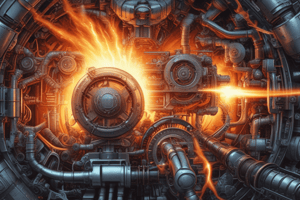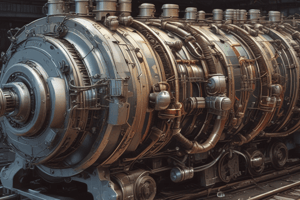Podcast
Questions and Answers
What are the 4 stages of combustion?
What are the 4 stages of combustion?
- Char burning (correct)
- Moisture evaporation (correct)
- Ignition of combustible gas (correct)
- Release of combustible gases (correct)
What is the total energy produced by burning one pound of wood?
What is the total energy produced by burning one pound of wood?
8,600 BTUs
What is the ignition temperature of wood smoke when using catalytic converters?
What is the ignition temperature of wood smoke when using catalytic converters?
500 degrees
What is the proper UL Standard for chimneys used to vent wood stoves?
What is the proper UL Standard for chimneys used to vent wood stoves?
What do the UL103HT requirements cover?
What do the UL103HT requirements cover?
According to NFPA 211, the maximum horizontal run of a wood stove connector is limited to ______________ percent of the vertical portion of the chimney above the connector.
According to NFPA 211, the maximum horizontal run of a wood stove connector is limited to ______________ percent of the vertical portion of the chimney above the connector.
According to NFPA 211, a manual damper installed in a wood stove connector pipe cannot block more than ___________ percent of the connector when fully closed.
According to NFPA 211, a manual damper installed in a wood stove connector pipe cannot block more than ___________ percent of the connector when fully closed.
According to NFPA 211, the maximum permitted chimney flue area is ______ times the appliance flue collar area for exterior chimneys and ____ times the appliance flue collar area for interior chimneys.
According to NFPA 211, the maximum permitted chimney flue area is ______ times the appliance flue collar area for exterior chimneys and ____ times the appliance flue collar area for interior chimneys.
The maximum chimney offset angle permitted in the United States is __________ degrees (from vertical).
The maximum chimney offset angle permitted in the United States is __________ degrees (from vertical).
According to NFPA 211 and the IRC, a 3.5" brick wall with a 1" ventilated air space provides a __________ percent clearance reduction.
According to NFPA 211 and the IRC, a 3.5" brick wall with a 1" ventilated air space provides a __________ percent clearance reduction.
According to NFPA 211 and the IRC, a 3.5" brick wall without ventilated air space provides a __________ percent clearance reduction.
According to NFPA 211 and the IRC, a 3.5" brick wall without ventilated air space provides a __________ percent clearance reduction.
According to NFPA 211 and the IRC, a 24 gauge sheet metal panel with a 1" ventilated air space provides a __________ percent clearance reduction when used as a ceiling protector.
According to NFPA 211 and the IRC, a 24 gauge sheet metal panel with a 1" ventilated air space provides a __________ percent clearance reduction when used as a ceiling protector.
The standard clearance to combustibles for an unlisted wood stove is ___________ inches.
The standard clearance to combustibles for an unlisted wood stove is ___________ inches.
What is UL 1618?
What is UL 1618?
What is Type 1 floor protection?
What is Type 1 floor protection?
What is Type 2 floor protection?
What is Type 2 floor protection?
What is R-value?
What is R-value?
Who writes gas products standards?
Who writes gas products standards?
What does ANSI Z21.50 apply to?
What does ANSI Z21.50 apply to?
What does ANSI Z21.8 cover?
What does ANSI Z21.8 cover?
What does ANSI Z21.9 refer to?
What does ANSI Z21.9 refer to?
What does ASTM E-1509 represent?
What does ASTM E-1509 represent?
What are the emission limits in the New Source Performance Standard (NSPS) for catalytic and non-catalytic woodstoves?
What are the emission limits in the New Source Performance Standard (NSPS) for catalytic and non-catalytic woodstoves?
According to NSPS, what are the two phases for woodstoves?
According to NSPS, what are the two phases for woodstoves?
What are the principles of draft and flow?
What are the principles of draft and flow?
What is natural draft?
What is natural draft?
What is flow in the context of chimney systems?
What is flow in the context of chimney systems?
What is a house stack effect?
What is a house stack effect?
What is mechanical draft?
What is mechanical draft?
Draft gauges are measured in____________.
Draft gauges are measured in____________.
What is the chimney connector pipe?
What is the chimney connector pipe?
Flashcards are hidden until you start studying
Study Notes
Combustion Stages
- Four stages of combustion: moisture evaporation, release of combustible gases, ignition of combustible gas, and char burning.
Energy Production
- Burning one pound of wood generates approximately 8,600 BTUs.
Ignition Temperature
- Catalytic converters can reduce the ignition temperature of wood smoke to around 500 degrees.
UL Standards for Chimneys
- Proper UL Standard for chimneys venting wood stoves is UL103HT.
UL103HT Details
- Covers factory-built chimneys for venting gas, liquid, and solid-fuel residential-type appliances.
Wood Stove Connector Limitations
- Maximum horizontal run of a wood stove connector is limited to 50% of the vertical chimney portion above the connector.
Manual Damper Regulations
- A manual damper in a wood stove connector pipe must not block more than 80% of the connector when fully closed.
Chimney Flue Area Regulations
- Maximum chimney flue area: 2 times the appliance flue collar area for exterior chimneys; 3 times for interior chimneys.
Chimney Offset Angle
- Maximum permitted chimney offset angle in the U.S. is 30 degrees from vertical.
Clearance Reduction Specifications
- A 3.5" brick wall with 1" ventilated air space provides a 66% clearance reduction.
- A 3.5" brick wall without ventilated air space provides a 33% clearance reduction.
- A 24 gauge sheet metal panel with 1" ventilated air space offers a 50% clearance reduction as a ceiling protector.
Clearance to Combustibles
- Standard clearance to combustibles for unlisted wood stoves is 36 inches.
UL 1618 Understanding
- UL 1618 provides two types of manufactured pads for floor protection: Type 1 for ember protection; Type 2 for thermal protection (requires an R value of 1.0).
R-Value Definition
- R-Value measures heat resistance, indicating thermal efficiency.
Gas Product Standards
- Gas product standards are outlined by ANSI (American National Standards Institute).
ANSI Standards Overview
- ANSI Z21.50: Standards for newly produced vented decorative gas appliances.
- ANSI Z21.8: Standards for installation of conversion burners.
- ANSI Z21.9: Standards for outdoor decorative appliances.
Room Heater Standards
- ASTM E-1509 specifies standards for room heaters and pellet fuel burning.
Emission Limits under NSPS
- New Source Performance Standard emission limits set: 4.5 grams/hour for catalytic stoves and 7.5 grams/hour for non-catalytic stoves.
NSPS Phases for Woodstoves
- NSPS consists of two phases:
- 1st phase: current limit is 4.5 grams/hour.
- 2nd phase (by 2020): reduction to 2.5 grams/hour with cord wood and 2.0 grams/hour with crib wood.
Principles of Draft and Flow
- Ensures exhaust flue gases exit to the outside, protects the home from hot gases and sparks, and draws in combustion air.
Natural Draft Dynamics
- Natural draft moves air into the appliance and expels combustion byproducts due to the temperature difference between gases and outside air.
Flow Definition
- Flow refers to the volume of gases that traverse the venting system due to draft.
House Stack Effect
- Occurs when a heated house portion is taller than the vent termination, creating additional chimney effect due to leaks and upper-window openings.
Mechanical Draft Utility
- Mechanical draft systems can remedy venting issues but must be listed and installed per specific instructions.
Measurement of Draft Gauges
- Draft gauges are measured in Water Column Inches.
Chimney Connector Pipe Function
- The chimney connector pipe connects the appliance to the chimney and is critical for proper venting.
Studying That Suits You
Use AI to generate personalized quizzes and flashcards to suit your learning preferences.





